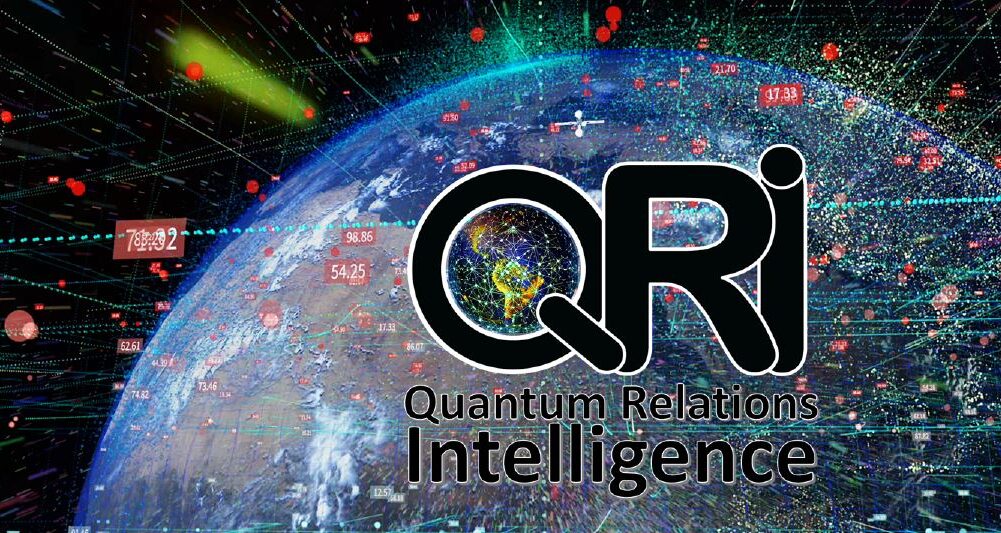QRI is a Cognitive Artificial Intelligence Technology that focuses on the analytical understanding of language, language sources, and their quantitative, qualitative, and associative features found within. QRI operates from the notion that language and numbers can be used as the primary medium of understanding our entire universe and all that is contained within. All things that are not language initially, such as images, videos, measurements, and natural or abstract phenomena, can also be expressed in language.
The analytical understanding of language media can be efficiently applied by QRI to historical and real-time data (in-stream analysis). It can be pre- and post-analysis filtered by sourcerelated and/or qualitative and associative parameters (for example, culture-centric, subjectcentric, POV-centric, conceptual-centric, event-centric, relationship-centric, etc.). QRI organizes the continuous stream of language effectively through a proprietary ontological system, which focuses in its center on any causal relationships (Causality) found in language between the eight cardinal cognitive entities of human understanding (see diagram below)

Essentially, QRI replicates ontologically and epistemologically how the human brain functions and processes information. However, it can do so without the typical limitations of the brain (for example, parallel learning, correctly remembering the sequential order of facts, remembering all history without distortion, preserving all quantitative, qualitative, and associative memory features, cross-domain contextual processing, etc.)
QRI can provide on an application level many features, which allow the solving of many intractable problems with traditional neural-net and machine-learning-centric AI systems, as the following diagram illustrates:

Commercial Implications of QRI
The commercial implications of QRI are groundbreaking, reshaping how the world operates and innovates. Imagine a system that processes vast amounts of data at lightning speed and learns and evolves through this data autonomously. QRI in government intelligence is profound, enhancing national security and strategic decision-making. QRI can analyze vast amounts of data from multiple vertical sources and domains, identifying patterns and potential threats that might go unnoticed by human analysts. This capability allows for more accurate and timely intelligence assessments, enabling proactive measures against security threats. In law enforcement, QRI is revolutionizing how agencies prevent and solve crimes. QRI policing algorithms analyze crime data to forecast potential evolving hotspots, allowing for more
strategic deployment of resources. QRI assists in investigations by analyzing digital evidence, identifying suspects, and predicting criminal behavior, leading to faster and more accurate case resolutions and fostering public trust in law enforcement agencies. QRI’s impact on news fact analysis is significant, combating the spread of misinformation and ensuring the credibility of information. QRI quickly scans and verifies facts across vast datasets, identifying false information and providing accurate context. This capability is crucial in today's fast-paced news environment, where misinformation can spread rapidly. QRI also assists journalists by analyzing trends and providing insights, allowing them to focus on in-depth reporting. In power management and forecasting, QRI drives efficiency and sustainability by analyzing data from smart grids and weather forecasts to optimize energy distribution and consumption. This leads to more efficient resource use, reducing waste and lowering costs. QRI helps find energy
demand with high accuracy, helping to prevent blackouts and ensure a stable power supply. This benefits energy providers and contributes to environmental sustainability by promoting more efficient use of renewable energy sources. QRI can be effectively used in real-time marketing, consumer research, and social trend detection. QRI can aid fields of medicine, drug research, agriculture, logistics, energy, finance, cyber security, and any other area where real-time data interpretation is critical.
By integrating QRI, governments, businesses, and organizations can achieve greater efficiency, accuracy, and innovation, ultimately driving growth and success in an increasingly digital world.
Application Examples
QRI is transforming the public and private sectors by enhancing efficiency, accuracy, and innovation. From govt intelligence to retail personalization, QRI solutions are revolutionizing organizations and industries and improving overall service delivery. Here are some specific examples of how QRI is making a significant impact.
Public Sector:
Healthcare: QRI-driven diagnostic can accurately analyze medical images (like X-rays
and MRIs), helping doctors detect diseases early. This reduces diagnostic time and
improves patient outcomes.
● Public Safety: QRI-based surveillance systems can detect unusual behavior and
potential threats in real time, allowing law enforcement to respond quickly. QRI
policing algorithms can also forecast crime hotspots, improving resource allocation.
● Environmental Monitoring: QRI can analyze data from sensors and satellites to monitor
air and water quality, helping governments respond more effectively to pollution and
environmental hazards.
● Threat Detection: QRI analyzes vast datasets from various sources to identify potential
security threats, enabling proactive measures and rapid response to national security
issues.
● Surveillance: QRI-powered facial recognition and behavior analysis enhance
surveillance capabilities, aiding in identifying and tracking suspects in real time.
Private Sector
● Retail: QRI-driven recommendation systems can offer personalized product
suggestions, improving customer satisfaction and boosting sales. QRI can also optimize
inventory management by predicting demand trends reducing waste and stockouts.
● Smart Grids: QRI optimizes energy distribution by analyzing real-time data from smart
grids, reducing energy loss and ensuring efficient power delivery.
● Predictive Maintenance: QRI predicts equipment failures in power plants, allowing for
timely maintenance and reducing downtime, enhancing overall grid reliability.
● Renewable Integration: QRI predicts renewable energy production (e.g., solar, wind)
by analyzing weather patterns, facilitating better integration of renewable sources into
the energy grid.
● Marketing: QRI can analyze consumer data to create highly targeted marketing
campaigns, increasing conversion rates and ROI. Natural language processing (NLP)
can also analyze customer feedback and improve product offerings.
These applications demonstrate the transformative potential of QRI in enhancing efficiency, accuracy, and innovation across various sectors.


